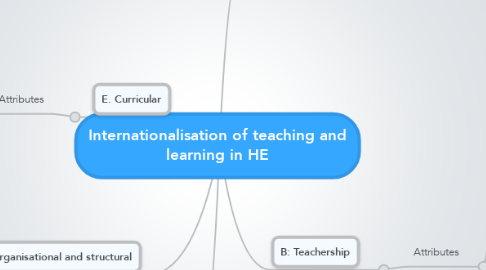
1. E. Curricular
1.1. Attributes
1.1.1. connection to research
1.1.2. special design of programs, recognition
1.1.3. mentoring
1.1.4. student training for the new environment
2. D. Organisational and structural
2.1. Attributes
2.1.1. Internationalisation as a process
2.1.1.1. Internationalisation slow and phased in practice
2.1.1.2. Individual teachers' development effors
2.1.1.3. Joint development efforts
2.1.1.3.1. Development days in own unit
2.1.2. Organisational resources and support
2.1.2.1. Support unclear
2.1.2.1.1. Internatinalisation as a strategic aim only serving administration?
2.1.2.2. Not necessary training available
2.1.2.3. Concern about oversize resource allocation for internationalisation
2.1.3. Adaptation and management of change (F)
3. C. Ethos and values
3.1. Attributes
3.1.1. Attitudes on foreign students/mobility (F)
3.1.1.1. Previously international students were expected to adapt independently
3.1.1.2. optimistic
3.1.1.2.1. Students get new knowledge and skills during exchange period abroad
3.1.1.3. pessimistic
3.1.1.3.1. Study breaks and prolonged study times of domestic students (who have participated in student exchange)
3.1.2. values
3.1.2.1. willingness
3.1.2.2. flexibility
3.1.2.3. tolerance /understanding
4. A. Teaching and learning environment
4.1. Attributes
4.1.1. Observing changes in student groups (F)
4.1.1.1. Growing number of international students
4.1.1.1.1. Multicultural classes
4.1.1.1.2. Both domestic and international students participate into the courses
4.1.1.1.3. International students as a teaching resource
4.1.1.2. Group processes between domestic and international students
4.1.1.2.1. Students don't like to work in mixed groups
4.1.2. environmental
4.1.2.1. internationalisation @ home
4.1.2.2. better student recruitment
4.1.2.3. mobility
4.1.2.3.1. of students
4.1.2.3.2. of staff
4.1.2.4. Considering/already participating in teacher exchange
4.1.3. transversal
4.1.3.1. intercultural exchange
4.1.3.2. collaboration between teachers
4.1.3.3. international recognition
4.1.4. Enlarging action field (F)
4.1.4.1. International co-operation neworks and contacts
4.1.4.2. Links to connecting international research and teaching
4.1.5. Changes in university teaching and learning environment (F)
4.1.5.1. Visiting scholars bring new sights into teaching
4.1.5.2. Fears that visiting teachers' may change too much the teaching culture
5. B: Teachership
5.1. Attributes
5.1.1. Teachership challenges (F)
5.1.1.1. The change of own teacher identity
5.1.1.1.1. Tolerance
5.1.1.1.2. Versatility
5.1.1.1.3. Enriching experiences
5.1.1.2. Giving up old is never easy
5.1.1.2.1. Token internationalisation
5.1.1.2.2. Fear of new
5.1.1.2.3. Fear of growing work load
5.1.1.2.4. Not excited about changes
5.1.1.3. Pressures of internationalisation
5.1.1.3.1. May cause feelings of inferiority
5.1.1.3.2. Danger of adding competition
5.1.1.3.3. Having to follow more and more international trends
5.1.2. personal
5.1.2.1. communication skills
5.1.2.2. motivation, willigness
5.1.2.3. being exposed to...
5.1.2.4. personal contacts have structural effects
5.1.3. pedagogical / methodology
5.1.3.1. teaching style (e.g. more examples)
5.1.3.2. students style changing (e.g. asking different and more question)
5.1.4. Challenges for...
5.1.4.1. recognising prior learning (e.g. modules)
5.1.4.2. more heterogenity
5.1.4.3. language learning
5.1.4.4. being trained for the new situation
